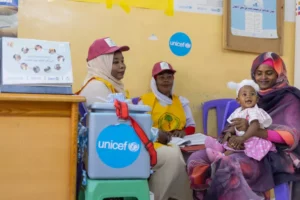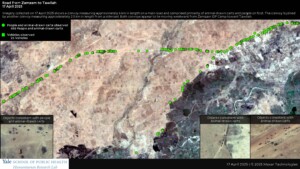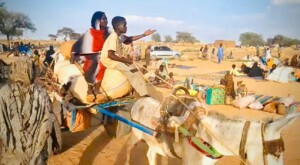Sudan OCHA bulletin 45: 227 cases of severe dengue fever cases reported
According to the Ministry of Health (MoH) between 29 August and 4 November, 227 suspected cases of severe dengue fever, including 110 deaths, were reported in Darfur.
27 new cases including six deaths were reported between 30 October and 4 November alone, the UN Office for the Coordination of Humanitarian Affairs stated in its latest weekly bulletin.
According to the Ministry of Health (MoH) between 29 August and 4 November, 227 suspected cases of severe dengue fever, including 110 deaths, were reported in Darfur.
27 new cases including six deaths were reported between 30 October and 4 November alone, the UN Office for the Coordination of Humanitarian Affairs stated in its latest weekly bulletin.
The highest number of reported cases is in West Darfur (135) followed by Central Darfur (46), North Darfur (37), East Darfur (nine) and South Darfur (one). The state with the highest fatalities is West Darfur (86) followed by North Darfur (15), Central Darfur (seven) and East Darfur (two).
Records indicate that many patients who tested positive for severe dengue fever were also infected with malaria. Dengue fever is endemic in many states of Sudan including South Kordofan, and the eastern Red Sea, Kassala, and El Gedaref states.
The MoH and the World Health Organization (WHO) have prepared a broad response plan. All initial response activities have started, however in order to implement a comprehensive response and containment plan, additional financial resources of about $1.94 million are needed. The Sudanese government has provided SDG3.45 million ($557,000), for the affected states.
According to the WHO, 75 percent of people infected with the dengue virus do not develop symptoms, 20 percent develop mild symptoms (fever, nausea and vomiting, and aches and pains) and about 5 percent develop severe dengue fever.
Measles cases reach 3,438, including 71 deaths
According to the MoH, as of 1 November the total number of confirmed measles cases in Sudan reached 3,438,with 71 fatalities affecting 72 localities in all 18 states in the country.
The majority of measles cases are among children under 15 years (73 percent). The highest number of reported cases is in West Darfur state (667) followed by Red Sea state (573), then Kassala state (539) and the lowest (13 cases) were reported from Blue Nile state. The state with the most deaths is North Darfur (23) followed by East Darfur (14).
The Common Humanitarian Fund (CHF) has provided funds for a measles vaccination campaign targeting about 4.4 million children between six months and 15 years. A further $3 million is needed to vaccinate an additional 2.7 million children in Northern and El Gezira states. Once these vaccination campaigns are complete, all children under 15 years in Sudan will have received at least one dose of the measles vaccine.
More than 4,000 returnees in Jebel Marra need aid
According to the Government’s Humanitarian Aid Commission (HAC) in Central Darfur, 4,190 displaced people who returned to their areas of origin in Jebel Marra are in need of humanitarian assistance.
The returnees fled their homes in February and March of this year following fighting between government forces and rebels. The people began to return during the past two months owing to improved security conditions. The returnees need to rebuild their lives, as their villages burned to the ground during the fighting. Emergency shelter, food, water, agricultural assistance, as well as health and education services are needed.
The nearest primary health facilities are in Guldo and Nierteti, at a distance of 30km and 53km respectively. The nearby Golo Hospital stopped operating in January of this year after it was looted.
Lean season will continue into early November
According to the Famine Early Warning Systems Network (FEWS NET) Food Security Outlook Report for October, with the late start of the rains and a delayed harvest in many places across Sudan, the lean season will continue into early November, instead of ending late September/early October.
The duration of the harvest this year will be shorter than normal, which will lead to less income generated from agricultural labour and the lower yields will reduce income from cash crops. High food prices will erode the ability of many poor households to pay for all their essential non-food needs as the need to purchase food will likely continue throughout the remainder of the year.
Displaced people in conflict-affected areas of South Kordofan, Blue Nile, and Darfur are likely to remain food insecure with many areas experiencing 'crisis levels' of food insecurity. These people generally need to buy food from markets, but there are few opportunities to earn an income. Many families with access to land will still have below-average harvests, and others will be unable to harvest or store their crops.
A significant number of displaced people in Darfur will be able to meet their food needs and will remain in 'stressed levels' of food security but only with the availability of humanitarian assistance.
High food prices in Blue Nile State
The number of food insecure people in Blue Nile State has risen as a result of increased staple food prices, the Blue Nile State Sudan Food Security Technical Secretariat (SFSTS) reported in its Monthly Food Security and Nutrition Update for October.
Rainfall in the state was below average from May to July and above average in August. The increased rainfall in August and September has improved the overall rainfall performance this season, however, the rainfall received this year is still lower than the same period last year which will likely lead to a lower harvest.
The World Food Programme (WFP) resumed its general food distributions in October, distributing about 897 metric tons of food to some 26,000 people in Ed Damazin and El Roseires localities who were displaced from Bau locality in May. Consequently, HAC in Blue Nile reported that the food security of displaced people in the state was stable in October.
The general health conditions throughout the state have slightly deteriorated during the months of September and October, the MoH reported. Malaria admissions have increased by 38.8 percent in September compared to August, which is mainly attributed to the increased rains. Other epidemic diseases such as tuberculosis, dysentery, and typhoid have shown slight increases, according to the MoH. Nutrition in the state has shown a noticeable improvement.
A decline in severe acute malnutrition admissions from August to September was recorded after the opening of two new nutrition centres, run by Save the Children Sweden (SCS) in partnership with the national Friends of Peace and Development Organisation (FPDO) in Kurmuk and Bau localities, and widespread coverage of mobile health services in the state.
Read the full OCHA Sudan news bulletin here











 and then
and then